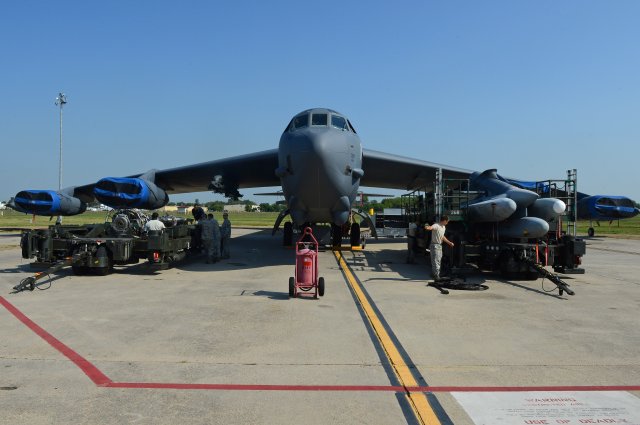Breaking news
USAF bomber crews start training with upgraded B-52H Stratofortress.
| a | |||
|
|
|||
|
World Aviation Defense & Security News - United States
|
|||
|
|
|||
|
USAF bomber crews start training with upgraded B-52H Stratofortress
|
|||
|
The last B-52 Stratofortress rolled off the assembly line in 1962, but while the airframe itself is well-seasoned, the internal components are continually upgraded to keep up with the demands of the modern battlespace. Efforts like the Military Standard 1760 Internal Weapons Bay Upgrade program aim to keep the bomber at the forefront of U.S. power projection for decades to come. Last week, the 96th Bomb Squadron became the first operational unit to employ this latest upgrade during a local training mission.
|
|||
|
|
|||
 Airmen from the 2nd Maintenance Group weapons standardization prepare to load a strategic rotary launcher and an air launch cruise missile pylon to a B-52H Stratofortress on Barksdale Air Force Base, La., Aug. 20 2015 Airmen from the 2nd Maintenance Group weapons standardization prepare to load a strategic rotary launcher and an air launch cruise missile pylon to a B-52H Stratofortress on Barksdale Air Force Base, La., Aug. 20 2015(Credit: USAF/Senior Airman Micaiah Anthony) |
|||
|
|
|||
|
“The IWBU to the B-52H provides increased carriage capability for precision weapons to include the GPS-guided Joint Direct Attack Munition,” said Capt. Kenny, a 96th Bomb Squadron instructor weapon systems officer. “This new capability also extends our range by reducing the amount of drag that external weapons produce.”
“JDAMs use a digital architecture in conjunction with a software component called a Stores Management Overlay to communicate with the aircraft,” Kenny said. “The B-52’s pylons have had the capability to speak to the digital systems on precisions weapons like JDAM for years, while the bomb bay remained analog and only capable of dropping unguided conventional weapons. That’s where the IWBU comes in.” The first increment of the IWBU rewires the B-52’s internally carried conventional rotary launcher, allowing it to house and communicate with up to eight J-series weapons. It also reconfigures the external pylons to carry up to 16 of the laser-guided JDAM variant. “IWBU nearly doubles the number of JDAMs a single plane can carry,” Kenny said. “This gives us the option to reduce the number of aircraft required to execute a mission, lowers our fuel requirements and provides us with more flexible loadouts, enabling us to strike a wider range of target types during any given mission.” The next increment of the program will allow the B-52 to internally carry eight joint air-to-surface standoff missiles, as well as a variety of miniature air-launched decoys. It will also give the B-52 the option of carrying up to 12 extended-range JASSM-ERs on the external pylons for a total capacity of 20 of these advanced, stealthy cruise missiles. As the oldest bomber in the Air Force inventory, the B-52 has often been the target of replacement programs. In the 60 years since the B-52 first came onto the scene the Air Force has debuted six heavy bombers, of which only three are still flying, including the B-52 itself. The recently announced B-21 aims to finally replace the venerable Stratofortress, but will not be fielded until the mid-2020s. In the interim, the B-52 is projected to continue operations until at least 2040. To facilitate flying into its 90th year, the bomber is constantly being fitted with upgraded components. The current “H” model features multi-function digital display screens, computer network servers and real-time communication uplinks with Internet access. “The B-52 has always been capable of executing a wide variety of missions,” Kenny said. “The IWBU provides more flexibility and capability in order to more effectively execute these diverse set of missions across numerous combatant commands.” |
|||
,



















